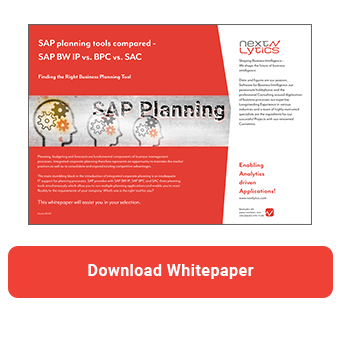Companies often face the challenge of coordinating their planning processes. With dozens or even hundreds of planners, it is very difficult to keep track of their progress. In addition, companies need workflow functions so that, for example, the results of a planner are submitted to their manager for approval. Once the plan has been approved, the values should be automatically locked to ensure the consistency of the plans.
In this article, we will look at how the most common planning tools, SAP Business Planning and Consolidation (SAP BPC) and SAP Analytics Cloud (SAC), address these challenges. Let's look at BPC first.
BPC Business Process Flow
SAP BPC uses Business Process Flows (BPFs) to guide users through the planning application. These represent a structured sequence of business processes. BPFs are primarily used to standardize recurring processes. This ensures that everyone involved goes through the same steps.
The configuration of BPFs is implemented using process templates. In these templates, the workflow is defined via activities. Several process instances can then be created based on one process template. For example, planning can be carried out each month using a process template. The following image illustrates the interaction between process templates and process instances.

The processor and reviewer of the respective activity are selected either using the attributes of a dimension (e.g. company code) or manually when the process instance is started. Alternatively, the roles can be determined using a BAdI. However, the latter option requires knowledge of ABAP programming.
A process step can include different types of tasks, such as executing various consolidation steps, opening a business warehouse query or an Analysis for Office workbook. If these contain variables, values can be assigned to the variables. You can also fill the variable values automatically from the workspace context. External resources can also be called via a URL. Finally, the work status can also be set to lock the plan values.
As soon as the process is started, the SAP system automatically sends emails to users to inform them of the upcoming tasks. This means that everyone involved always has an overview and can access relevant activities directly - simply by clicking on the link contained in the email. You can switch individual notifications on or off using the RSBPCB_MAINTAIN_EMAIL_TMPL email template maintenance programme. In addition to emails, the planners involved in the process can exchange information via integrated comments.

To monitor the progress of the process, BPC offers a range of reports aimed at different types of users. While the ‘My activities’ section and the process monitor provide planners and auditors with valuable insights into ongoing processes, the instance and activity reports are intended for administrators.
The ‘My activities’ area provides the planner with an overview of all the activities assigned to them. Selecting an activity takes the user to the corresponding activity area, where they can carry out their tasks or review the created plans. This area contains hyperlinks that can be used to complete the individual tasks directly.
In the process monitor, the process owner sees a list of all instances that they can access as the owner. An overview of all processes is displayed with the process name, the process context, the status with the progress and the number of completed activities, the start date and the owner of the individual process instances.
There are also two reports for the system administrator: the instance report and the activity report. The instance report shows all process templates including the version. Once the administrator has selected a released version, they can generate an instance report and view the number of completed, open and pending activities. The activity report fulfills a similar function. The status, history and current processors and reviewers, including deadlines, are clearly displayed. You will also find all comments that were created during the planning phase.
To summarise, the Business Process Flow meets the usual requirements for a structured planning process. However, the setup is rather rigid and customising has to be done via the backend. In practice, we therefore often observe that customers prefer to design their planning workflows themselves via central landing pages with various jump-off points or Analysis for Office (AfO) workbooks with many worksheets instead of using Business Process Flows. The existing functions are perceived as too complex and overloaded to implement a flexible planning process. By mixing various consolidation functions with the planning function, the business process flow appears too overloaded and confusing. This is why SAP is taking a radically different approach with SAP Analytics Cloud (SAC), focussing on flexibility and simple setup.
SAP Planning Tools Compared -
Download the Whitepaper here!
SAP Analytics Cloud Calendar
With the calendar in SAC, SAP takes a completely different approach to BPFs. Instead of the complex structure using templates and instances, SAP Analytics Cloud (SAC) works with different task types that can be combined into one process. In addition to the general task and the review task, a composite task can also be used. It combines the actual task and the review in one step. The planned values can be locked using a data locking task to prevent changes. Data actions and multi-actions can also be scheduled using the calendar.
In addition, data actions and multi-actions can also be scheduled using the calendar, which is not possible in SAP BPC. In BPFs, all planning logic must be implemented in Analysis for Office workbooks, which then can be accessed via hyperlinks.

The different task types can be linked to each other and combined using a process. These in turn can be added to a higher-level process. The duration of the respective tasks can be customised and the processors and reviewers can also be determined flexibly. This means that the entire workflow can be set up in just a few minutes and flexibly adapted as required. In addition to the ad-hoc setup, events can also be generated via a wizard. The procedure is then similar to BPC, but without the tedious configuration of process templates.

As soon as the process has been started, the user receives a notification in SAC as well as an email. In addition, thanks to the integration with Microsoft Outlook, the activities can also be viewed directly in the Outlook calendar. The system administrator can define in the settings which notifications are sent via in-app notifications or emails.

In addition to the in-app notifications and emails, the native discussion function can also be used to orchestrate the planning process. SAC's outstanding commenting functions and the ability to create comments both at story level and on individual cells further enhance the informative content.

Compared to SAP BPC, which distributes the information relating to the business process flow across four different reports, SAC's reporting is highly standardised. All information is collated in a user interface that offers various views. In addition to the view with the Gantt chart, the processes and associated tasks can also be displayed as a simple list. Alternatively, the process can also be displayed in the form of a calendar.
In addition, administrators can gain insight into all processes and tasks via the administrator mode. The intuitive user interface enables centralised management and monitoring of your planning processes. Users with the admin role can also act as substitutes and thus ensure the processing of events, regardless of the availability of those responsible.

Overview of solutions
Now that the two solutions have been presented, we can compare them based on criteria such as configuration, collaboration and reporting. SAP Analytics Cloud impresses with its simple configuration and flexibility.
|
Area |
SAP BPC |
SAC |
|
Configuration |
Quite rigid setup via process template and process instances. If changes are made, the process instance must be aborted and the template adjusted. Customizing must be done in the backend. |
Flexible configuration via an intuitive user interface. In addition to manual ad-hoc configuration, a wizard is also available. |
|
Available task types |
Consolidation: opening a journal list, creating a new journal, opening consolidation monitor, opening ownership manager, opening controls summary, and opening controls details. Query hyperlink, Analysis for office hyperlink, work status (locking), external resources. |
General task, review task, composite task, data locking task, data action task, multi action task. |
|
Collaboration |
EFmail notifications and comments. |
In addition to email notifications and comments, there are also in-app notifications. Discussions can also be used. |
|
Reporting |
Four different reports: two each for planners/inspectors and administrators. |
All information in a uniform user interface. |
Since many customers already use an existing SAP BW including SAP BPC for planning and also SAC for reporting and dashboarding, a combination of both tools is also an option. In addition to using BPC via Live Connection, where SAP Analytics Cloud acts as the front end and BPC's planning engine is used, Analysis for Office planning workbooks can also be saved on SAC and accessed via a URL in the calendar.
In the first case, the BPC Live Connection needs to be configured and the stories set up in SAC, which involves a lot of implementation work. The second option simply reuses the existing Analysis for Office workbooks with the input-ready queries and planning functions they contain. Instead of saving the workbooks on the BI platform or in BW, they are simply stored in SAP Analytics Cloud. This option is available from AfO version 2.8 SP18.

Coordinated planning processes - Our Summary
Both tools, SAP BPC Business Process Flow and SAP Analytics Cloud Calendar, serve their purpose and enable the orchestration of planning processes. In my experience, however, business process flows are rarely used in practice as they are difficult to set up and cumbersome to maintain. Due to the architecture with process template and process instance, all changes must be made to the template first and then a new process instance must be started. In addition, advanced customizing is only possible in the backend. The business department is often overwhelmed with setting up a process template, let alone backend customizing.
SAP Analytics Cloud, on the other hand, impresses with its intuitive, user-friendly interface. The planning process is implemented as a series of activities that can be linked to each other and assigned to a higher-level process. This allows users from the business department to click together the planning process in minutes without the support of the IT department. In the event of unavoidable changes and delays, the process does not have to be aborted, but can be easily adapted.
The beauty of the SAP ecosystem is that both tools can also be used in parallel. This means that you can benefit from the SAC calendar functions without having to forego the investments you have already made in BPC. Do you have any questions on this or other topics? Simply get in touch with us - we look forward to exchanging ideas with you!
SAP Analytics Cloud, SAP Planning

/Logo%202023%20final%20dunkelgrau.png?width=221&height=97&name=Logo%202023%20final%20dunkelgrau.png)
























